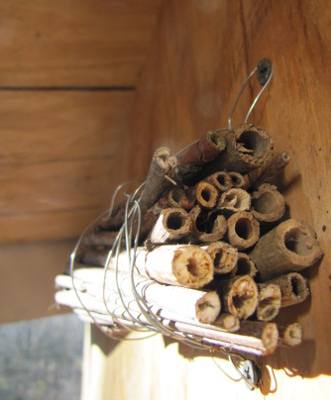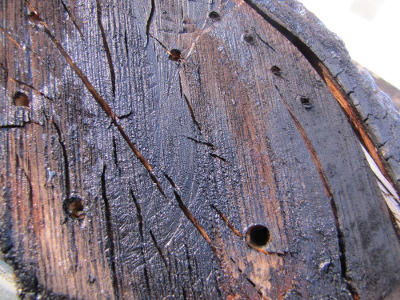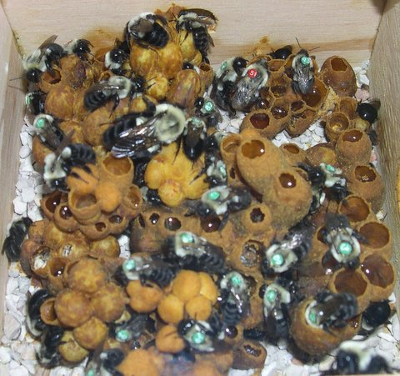
Nesting habitat for native bees
 The second requirement of
native bees is nest sites --- spots for the insects to raise their
young. About 70% of American native bees are ground nesters,
which dig (or take over) holes in the soil, while the other 30% are
tunnel nesters that primarily nest in abandoned beetle burrows in
stumps and snags. Keep your eyes open and protect any nest sites
you see, then you can choose whether to make additional habitat for
bees to move into.
The second requirement of
native bees is nest sites --- spots for the insects to raise their
young. About 70% of American native bees are ground nesters,
which dig (or take over) holes in the soil, while the other 30% are
tunnel nesters that primarily nest in abandoned beetle burrows in
stumps and snags. Keep your eyes open and protect any nest sites
you see, then you can choose whether to make additional habitat for
bees to move into.
Ground nesting bees
require undisturbed, bare soil, preferably sandy or loamy and always
unmulched. If they had their druthers, most would choose a
south-facing slope in full sun (or with afternoon shade) so that they
can warm up quickly first thing in the morning. Constructing
ground nesting habitat can be as simple as laying down a kill mulch on
a small patch of ground, then raking back the organic matter in the
spring to leave bare soil for the bees.
 Tunnel nesting bees are the
ones gardeners often build habitat for. If you have a dead tree
somewhere that's not going to crush your house, leave it in place (and
maybe drill some extra holes in the trunk) and bees will naturally move
in. You can plant elderberries, raspberries, blackberries, or
sumac since some bee species hollow out the pith in the center of these
plants' dead branches to create nest tunnels. Or you can make
designated nest boxes out of a block of wood, bundles of weeds or
bamboo stems, or adobe blocks --- I'll give specifics in Weekend
Homesteader: March (and will probably post about some of my experiments
sooner), or you can download
this fact sheet from the Xerces Society.
Tunnel nesting bees are the
ones gardeners often build habitat for. If you have a dead tree
somewhere that's not going to crush your house, leave it in place (and
maybe drill some extra holes in the trunk) and bees will naturally move
in. You can plant elderberries, raspberries, blackberries, or
sumac since some bee species hollow out the pith in the center of these
plants' dead branches to create nest tunnels. Or you can make
designated nest boxes out of a block of wood, bundles of weeds or
bamboo stems, or adobe blocks --- I'll give specifics in Weekend
Homesteader: March (and will probably post about some of my experiments
sooner), or you can download
this fact sheet from the Xerces Society.
 Finally, bumblebees require a
special set of nesting conditions --- a warm, dry place near or under
the ground about the size of a shoe box. You
can build (or buy) nest boxes, but the authors of Attracting
Native Pollinators report that only about a quarter of these boxes
get lived in. A simpler approach is to let grass grow up in an
out-of-the-way spot; when it falls over in the winter, mice will move
in and build nests, then bumblebees will take over in the spring.
Alternatively, you can make piles of brush or stone that create similar
cavities.
Finally, bumblebees require a
special set of nesting conditions --- a warm, dry place near or under
the ground about the size of a shoe box. You
can build (or buy) nest boxes, but the authors of Attracting
Native Pollinators report that only about a quarter of these boxes
get lived in. A simpler approach is to let grass grow up in an
out-of-the-way spot; when it falls over in the winter, mice will move
in and build nests, then bumblebees will take over in the spring.
Alternatively, you can make piles of brush or stone that create similar
cavities.
With the exception of
bumblebees, most native bees won't bother you even if you walk close to
their nests, so feel free to create habitat right outside your kitchen
window. Isn't a bee nest box more fun to watch than a bird feeder?
| This post is part of our Attracting Native Pollinators lunchtime
series.
Read all of the entries: |
Want more in-depth information? Browse through our books.
Or explore more posts by date or by subject.
About us: Anna Hess and Mark Hamilton spent over a decade living self-sufficiently in the mountains of Virginia before moving north to start over from scratch in the foothills of Ohio. They've experimented with permaculture, no-till gardening, trailersteading, home-based microbusinesses and much more, writing about their adventures in both blogs and books.
Want to be notified when new comments are posted on this page? Click on the RSS button after you add a comment to subscribe to the comment feed, or simply check the box beside "email replies to me" while writing your comment.
